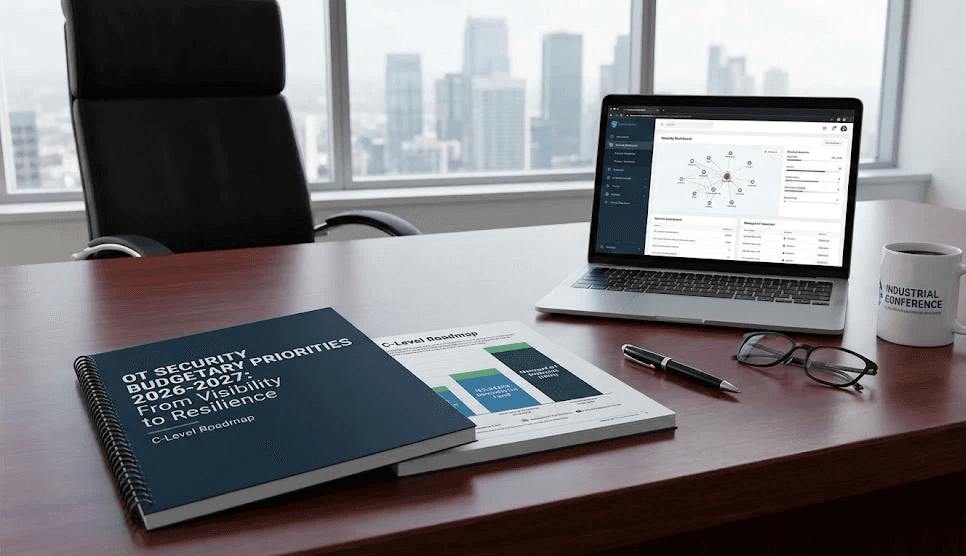

Prayukth K V
July 2, 2025
IEC 62443 compliance guide for small manufacturers
As per the findings of our latest OT cybersecurity threat landscape report, small manufacturers do face significant cybersecurity risks arising from convergence of IT and OT and automation of key operations. Cyberattacks on industrial control systems (ICS) and operational technology (OT) can lead to devastating outcomes across the infrastructure, including production downtime, regulatory fines, safety incidents, and severe financial losses.
The International Electrotechnical Commission (IEC) has developed the IEC 62443 series of standards that offer a comprehensive framework for securing industrial automation and control systems (IACS). While many perceive the IEC 62443 standards as a complex set designed for large enterprises, IEC 62443 is increasingly becoming a critical benchmark for all manufacturers, including Small and Medium Manufacturers (SMMs). Shieldworkz latest blog post aims to breakdown IEC 62443 for small manufacturers, highlighting its importance, key components, and a practical roadmap for achieving compliance without overwhelming your resources.
How can SMMs benefit from IEC 62443?
SMMs are often targeted precisely because they are perceived as having weaker defenses than larger corporations. They can serve as stepping stones for attackers to reach larger supply chain partners or be directly exploited for their valuable intellectual property or operational disruption. Further, SMMs data can also be held for ransom and access to their networks sold for a consideration by unscrupulous threat actors. Yes, this is certainly a plausible scenario.
Here’s why IEC 62443 compliance is not just a recommendation but a growing necessity for SMMs:
· Business continuity, assurance and asset availability: By conducting an IEC 62443 based cybersecurity assessment, security gaps can be identified for remediation on priority.
· Chart a security roadmap that evolves as you grow: When SMMs turn into bigger enterprises, a culture of risk sensitivity and mitigation can help secure them in the long run in a more sustainable manner.
· Enhanced security posture: At its core, IEC 62443 provides a structured approach to identify, assess, and mitigate cybersecurity risks within your OT environment. It moves beyond basic IT security to address the unique challenges of industrial systems, such as real-time operations, legacy equipment, and safety-critical functions. Implementing these standards significantly strengthens your defenses against a wide range of cyber threats.
· Supply chain requirements: As larger enterprises become more cyber-mature, they are increasingly pushing cybersecurity requirements across their supply chains. If you are a supplier to a larger company, demonstrating adherence to standards like IEC 62443 can become a prerequisite for doing business. Non-compliance could mean losing valuable contracts.
· Risk mitigation and business continuity: A cyberattack can halt production, damage equipment, and erode customer trust. By proactively implementing IEC 62443, you reduce the likelihood and impact of such incidents, ensuring business continuity and protecting your bottom line.
· Regulatory scrutiny: While not universally mandated for all SMMs yet, regulatory bodies are increasingly looking at industrial cybersecurity across the board. Proactive compliance can help you stay ahead of potential future regulations and avoid penalties.
· Competitive advantage: In a competitive market, demonstrating a robust cybersecurity posture can make your business stand out. It signals to customers and partners that you are a reliable and secure entity that is capable of protecting sensitive data and maintaining operational integrity.
· Insurance benefits: Some cybersecurity insurance providers may offer better terms or require adherence to recognized standards like IEC 62443 as a condition for coverage.
What is the IEC 62443 series all about?
As you may be aware, the IEC 62443 series is not a single document but a collection of standards, technical reports, and guidelines that are basically organized into four main categories:
· General (62443-1-x): These standards provide an overview, concepts, and terminology.
· Policies & Procedures (62443-2-x): These focus on the requirements for security programs for IACS asset owners and service providers.
· System (62443-3-x): These address system-level security requirements, including security levels, methods of risk assessment, security zones, and conduits.
· Component (62443-4-x): These specify technical security requirements for IACS products and components with a focus on lifecycle security.
For most small manufacturers, it's not about implementing every single standard, but rather understanding the core principles and applying the relevant parts to their specific environment.
How can small manufacturers work towards an IEC 62443 compliance roadmap?
Before diving into a strategic compliance roadmap, let's highlight some fundamental concepts within IEC 62443 that are particularly relevant for SMMs:
1. Risk assessment: This is the cornerstone of IEC 62443. You can't secure what you don't see and understand. A thorough IEC 62443-based risk assessment covers security gaps, training deficiencies, lack of role clarity, outdated security practices, potential threats, vulnerabilities, and their potential impact on your operations. For SMMs, this doesn't need to be an overly complex exercise; focus on your critical assets and the most likely attack vectors. In fact with a proven IEC 62443 OT security risk assessment vendor like Shieldworkz, this task become even easier.
2. Zones and conduits: This concept involves segmenting your network into logical "zones" based on their security requirements and criticality. "Conduits" are the communication pathways between these zones, and they must be secured. This helps contain breaches and prevent lateral movement of attackers. Even a small network can benefit from basic segmentation.
3. Security Levels (SL): IEC 62443 defines four security levels (SL1 to SL4), indicating the robustness of security measures required to protect against different levels of attack sophistication. SL1 offers protection against casual or coincidental violations, while SL4 protects against highly sophisticated attacks. SMMs typically aim for SL1 or SL2 for most of their systems, depending on criticality.
4. Defense-in-Depth: This principle advocates for multiple layers of security controls, so if one fails, others are still in place. Think of it like an onion: firewalls, intrusion detection, strong authentication, secure configurations, and employee training all contribute to a robust defense.
5. Product Security (Secure by Design): While SMMs might not be developing complex IACS products, they often integrate components. The standard encourages selecting products that are "secure by design," meaning security features are built in from the ground up, rather than bolted on as an afterthought.
How does an IEC 62443 Compliance roadmap for small manufacturers look like?
Step 1: Leadership Commitment and Awareness
· Secure Buy-In: Cybersecurity is not just an IT or OT issue; it's a business risk. Get commitment from top management. This ensures resources are allocated and that cybersecurity is integrated into the company culture.
· Basic Training: Educate key personnel (management, IT, OT, and even general employees) about the importance of industrial cybersecurity and the basic principles of IEC 62443. Awareness is the first line of defense.
Step 2: Define Scope and Conduct a Focused Risk Assessment
· Identify Critical Assets: What are the most crucial systems, processes, and data in your manufacturing operation? Focus your initial efforts on these. This might include your SCADA systems, PLCs, critical machinery, and proprietary recipes or designs.
· Initial Risk Assessment: Don't aim for perfection initially. Conduct a high-level risk assessment to identify obvious vulnerabilities and threats. This can be done with internal teams or with the help of an external consultant specializing in OT security.
· Define Target Security Levels: Based on your risk assessment, determine the appropriate Security Levels (SL) for your critical assets and systems. For many SMMs, SL1 or SL2 will be a realistic and effective starting point.
Step 3: Implement Foundational Security Controls (Based on IEC 62443-2-4 & 3-3)
This is where the rubber meets the road. Focus on practical, impactful controls.
Network Segmentation (Zones & Conduits):
· Logically separate your OT network from your IT network using firewalls.
· If possible, segment within your OT network (e.g., separate critical control systems from less critical ones).
· Implement strict access controls and monitoring for communication between zones.
Access Control and Authentication:
· Implement strong password policies and multi-factor authentication (MFA) where possible.
· Enforce the principle of least privilege: users and systems should only have the minimum access necessary to perform their functions.
· Regularly review and revoke access for employees who have left or changed roles.
Patch Management Strategy:
· Develop a plan for patching OT systems. This is often more complex than IT patching due to uptime requirements and vendor dependencies.
· Prioritize patches for critical vulnerabilities.
· Test patches in a non-production environment before deploying them to live systems.
· Consider virtual patching solutions if direct patching is not feasible for legacy systems.
Secure Configuration Management:
· Harden your systems by disabling unnecessary services, ports, and protocols.
· Change default passwords on all devices.
· Regularly back up configurations.
Malware Protection:
· Deploy endpoint protection (antivirus/anti-malware) on all IT and relevant OT endpoints.
· Ensure definitions are regularly updated.
· Implement application whitelisting on critical OT systems to prevent unauthorized software execution.
Logging and Monitoring:
· Collect logs from critical OT devices, firewalls, and security systems.
· Implement basic monitoring to detect unusual activity or potential security incidents. Even simple alerts can make a difference.
Physical Security:
· Don't overlook physical access to your control systems. Secure control rooms, server racks, and critical equipment.
· Implement access cards, locks, and surveillance as appropriate.
Step 4: Develop Security Policies and Procedures (Based on IEC 62443-2-1)
· Document Key Processes: You don't need a massive policy document. Start with clear, concise procedures for:
· Incident response (what to do if an attack occurs).
· Access control management.
· Patch management.
· Vendor risk management (how you assess the security of third-party products and services).
· Employee Training: Conduct regular cybersecurity awareness training for all employees, emphasizing phishing, social engineering, and safe internet practices. For OT personnel, focus on secure operational procedures.
Step 5: Incident Response and Recovery Planning
· Develop a Basic Incident Response Plan: Even a small manufacturer needs a plan for what to do if a cyber incident occurs. This should include:
· Roles and responsibilities.
· Communication protocols (internal and external).
· Steps for containment, eradication, and recovery.
· Regular Backups: Implement a robust backup and recovery strategy for all critical data and system configurations. Test your backups regularly to ensure they are restorable.
· Business Continuity Planning: Understand the impact of a cyberattack on your operations and develop strategies to maintain essential functions during and after an incident.
Step 6: Continuous Improvement and Review
· Regular Audits and Reviews: Periodically review your security controls and processes. Are they still effective? Are there new threats to address?
· Vulnerability Scanning: Conduct regular vulnerability scans of your IT and OT networks to identify new weaknesses.
· Stay Updated: The threat landscape is constantly evolving. Stay informed about new threats and vulnerabilities relevant to your industry.
· Seek Expert Help (When Needed): You don't have to go it alone. Consider engaging cybersecurity consultants specializing in OT for specific tasks like risk assessments, penetration testing, or developing complex policies. Many consultancies offer services tailored for SMMs.
Overcoming challenges
SMMs often face unique challenges in achieving cybersecurity compliance:
· Lack of management buy-in: Conduct awareness and training sessions to ensure senior leadership is sensitised on IEC 62443 compliance
· Lack of motivation: Always remember, secure organisations has one less challenge to worry about. IEC 62443 doesn’t just result in secure operations, it also saves cost of ransom, ensures worker safety, lower policy premium outgo and is your best bet against disruption due to a cyber incident
· Limited resources: Budget, personnel, and time are often scarce. Focus on high-impact, cost-effective controls first.
· Lack of specialized expertise: OT cybersecurity requires a different skill set than traditional IT. Invest in training existing staff or consider external partnerships with vendors such as Shieldworkz.
· Legacy systems: Older equipment may not support modern security features. Explore compensating controls like network segmentation, firewalls, and application whitelisting.
· Production Demands: The "always-on" nature of manufacturing makes it difficult to implement changes or take systems offline for security updates. Plan carefully and use maintenance windows.
IEC 62443 compliance for small manufacturers is certainly not an insurmountable barrier. Instead it is a journey that begins with a single step: recognizing the critical importance of securing your OT environment. By adopting a phased, risk-based approach, focusing on the most relevant parts of the standard, and leveraging available resources, SMMs can significantly enhance their cybersecurity posture.
Investing in IEC 62443 compliance is about safeguarding your operations, protecting your intellectual property, ensuring worker safety, and building a more resilient and competitive manufacturing business in an increasingly digital world. Start small, stay persistent, and remember that every step you take towards a more secure industrial environment is a step towards long-term operational excellence.
Talk to us now for an exclusive IEC 62443 compliance offer for your business from Shieldworkz.

Get Weekly
Resources & News
You may also like
Jan 8, 2026
The 2026 OT security blueprint: transitioning from "visibility" to "resilience"

Prayukth K V
Jan 7, 2026
Deciphering the coordinated GPS spoofing attacks on Indian airports

Prayukth K V
Jan 6, 2026
Rail cyber resilience in 2026: Leveraging the TS 50701 assessment

Prayukth K V
Jan 5, 2026
The 2026 Guide to ANSSI OT risk assessments

Prayukth K V
Jan 2, 2026
Beyond the final frontier: A report on the 200GB ESA data breach

Prayukth K V
Dec 31, 2025
OPLAN DEU and the new era of German cyber resilience

Prayukth K V











